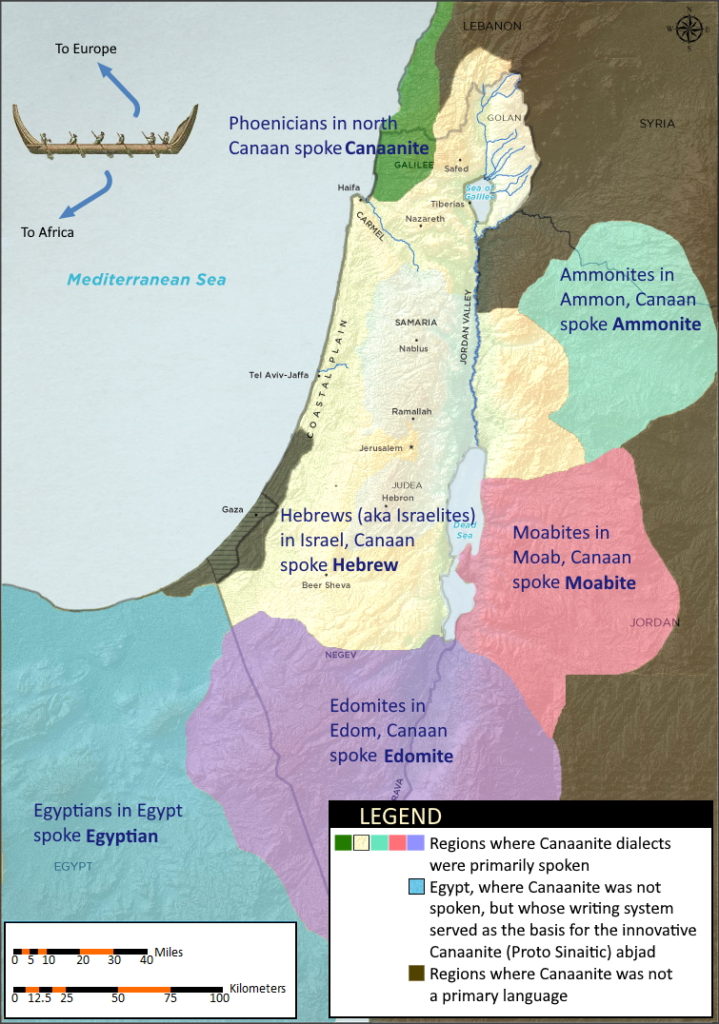
Hebrew’s Canaanite Roots
We learn in the Evolution of Writing that, for what must have been centuries before their 1850 BCE adoption of the vowel-free 22-letter abgad, Paleo Hebrew (essentially Hebrew) was the original language of the Hebrews in Canaan.
Consider what a technological leap forward this was: Compared with the Egyptian hieroglyphs, this 22-letter writing system is exponentially simpler and quicker to learn and use, making writing accessible to all, for the first time in history.

A Shared Abgad & Mutually-Intelligible Canaanite Languages
The Hebrews or Israelites were but one Canaanite that adopted the abgad. Over time, the region’s parent Canaanite language differentiated into several mutually-intelligible languages:
- Phoenician: Spoken by an indigenous Canaanite maritime culture whose writing system was adopted and modified by the Greeks. The name Phoenician is an exonym. That is, they did not refer to themselves as Phoenicians. As we understand it, they called themselves Canaanites, or by the cities of their heritage (e.g., Berut, Sydon).
- Paleo Hebrew: Spoken by indigenous Canaanite Israelites, Hebrew was the predominant language of the Kingdoms of Israel and Judah. Paleo Hebrew was preserved through the centuries that followed and gave rise to modern Israeli Hebrew in the 19th century CE.
- Ammonite: Spoken by an indigenous Canaanite culture, now lost, whose principle city was Rabbath Ammon. The New Testament referred to this city as Philadelphia. Today, its location is Amman, Jordan. And, in Hebrew, we still call the city Rabbath Ammon.
- Moabite: Spoken by the indigenous Canaanite culture. Our knowledge of this group is limited, with the Mesha Stele being the only known extensive text in Moabite.
- Edomite: Spoken by an indigenous Canaanite culture of which not much is known today. Their existence, however, is corroborated by multiple sources.
Over time, these indigenous Canaanite cultural groups scattered across the globe. Of all these groups, only the Jews (descendants of the Israelites, Samaritans included) have managed to retain their history, origin story, and culture. It’s quite remarkable, when you think about it.
What’s in a Name?
The following terms (that many people confuse) are closely-related, but each has a different meaning:
- Hebrew: In context of languages, Hebrew is a language name. In context of people, Hebrew refers to an ancient Israelite.
- Jew: A Jew is a person who is either genealogically linked to the ancient Israelites or to a person who has adopted the religion of Judaism.
- Jewish: Jewish is the adjective form that relates to the noun Jew.
- Israeli: In the context of people, an Israeli is a citizen of the State of Israel. Israeli is also used to describe things related to Israel.
- Israelite: An Israelite was a Canaanite whose culture, customs, religion, language, or residence made them a member of this group. Israelites were also called Hebrews.
Hebrew or Israelite society grew and developed into a tribal confederation, then a kingdom. Eventually, the kingdom split into two:
- Israel in the north of Canaan, eventually defeated and crushed by Assyria. Israel is also the name of the Jewish state.
- Judah in the center and south of Canaan, eventually defeated and crushed by Rome. The definition of Jew varies among religious groups.